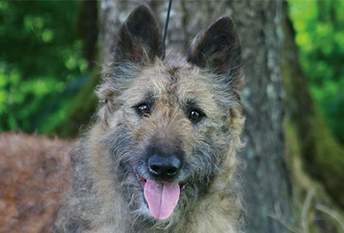The Bouvier’s coat needsbrushingonce or twice a week. A good slicker brush or pin brush and large comb will work for this. The beard may need cleaning at the same time, and the dog’stoenailsshould be trimmed every week or two.
Bouviers are athletes so they do need quite a bit of heavy exercise each and every day. Even if they appear to be in a lazy mood, you will need to get him up off the couch, out into the yard and playing.
Without sufficient exercise, the Bouvier des Flandres can become destructive. Inside of a few hours, you could come home to a house that looked like a hurricane hit it! Vigorous and prudent exercise is a must for this breed. Of course, he should only be exercised on a leash or inside a secure area.
The sheer size and energy level of the Bouvier required him to be fed a large amount of high-quality dry kibble. Because of his activity level, the Bouvier des Flandres should be fed twice daily instead of one large meal. This will help to prevent a condition known as gastric torsion or more commonly, bloat. This is a life-threatening problem so it is better to err on the side of caution.
Bouviers are generally healthy dogs, andresponsible breederswill screen their stock for health conditions such as Bouvier des Flandres myopathy, cataracts, deafness, ectopic ureters, epilepsy, glaucoma, hip dysplasia, hypothyroidism, laryngeal paralysis, megaesophagus, elbow dysplasia, portosystemic shunt, and subaortic stenosis.
Like all large and deep-chested breeds, theBouvier can experience gastric dilatation andbloat.Owners should learn how to identify this potentially life-threatening condition and learn what emergency steps to take to address it.
The Bouvier is happiest when he has a job to do, whether that job is babysitting, herding, obedience, or guard dog or rescue work. Bouviers are easily trained to do almost any type of dog sport or activity, and they usually excel at it.
They have a strong prey drive so they should be well socialized from the start. They are consummate showmen and enjoy working or competing with their owners at their side.
Extremely eager to please, once they know what you want them to do, they will do their best to satisfy you. This breed is well suited for search and rescue work and adapts to the training easily.












